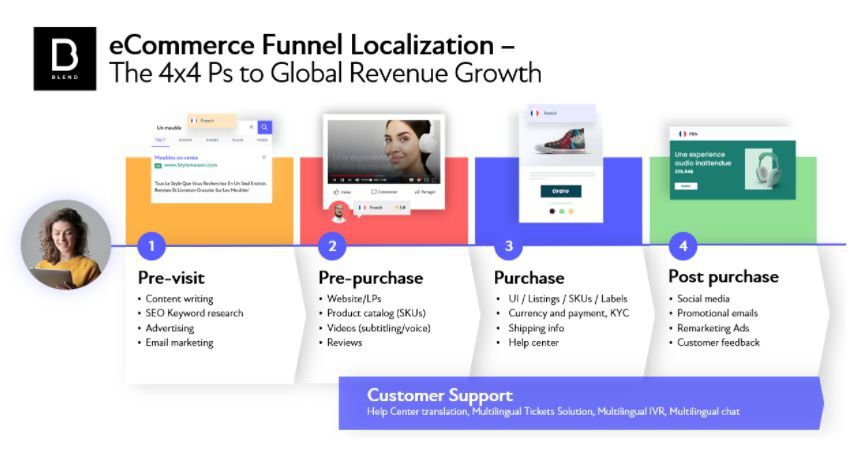Yair Tal
As BLEND’s CEO, Yair Tal brings extensive experience leading B2B and enterprise companies that provide global solutions.


Last month, it was my pleasure to speak at SlatorCon Remote on one of the localization industry’s most trending topics – eCommerce global growth. March 2020 marked a turning point in the history of eCommerce since global giants like eBay, Amazon, and PayPal took off in the late ’90s. The way that successful sellers today do business has forever changed.
It was mid-March 2020 when millions of businesses across the world were suddenly forced to shut their storefronts and grapple with a dilemma; should they go online, or wait for the pandemic to abate and foot traffic to return? Weeks went by, and as COVID seemed to be remaining for the near and foreseeable future, more and more businesses made the shift to online storefronts.
McDonald’s, Subway, KFC, and local restaurants alike began pivoting from restaurant dining to in-app ordering and curbside pickup. Netflix geared up on subtitles and dubbing in foreign languages to cater to the millions of additional users in countries around the world now stuck at home and seeking localized entertainment. Gap, JCPenney, and Macy’s all closed large swathes of retail real estate, taking more of their business online, directly to their now-homebound consumers.
And with millions of artisans that could no longer peddle their wares, Etsy’s numbers boomed from 2019 to 2020. The artisan platform reported more than double the previous year’s annual revenue – an unprecedented growth surge in the history of the company.
Millions of local merchants also turned to popular online platforms such as Wix, Shopify, WooCommerce, and Magento to take their local consumers’ shopping experiences online, shifting virtually overnight from in-store community orders to online purchases and shipping options.
On a consumer level, shoppers that once preferred to buy baguettes and brie at the local grocers now sought safer, contactless shopping methods.
From a pound of tomatoes for a comforting stew, to a brand-new Tesla for personal transport – shoppers, regardless of age or previous shopping habits, adapted their habits to suit the new pandemic-shaped retail reality.
Website? Check. Payment solution? Check. Shipping infrastructure? Check.
Now that businesses had invested the resources and built the infrastructure to support online commerce, the next major business step seemed only natural – cross-border sales.
The snapshot below shows recent data reported by Similarweb on July 2021’s top 50 eCommerce websites worldwide.

Among the top consumer sites, we can see companies from various countries and regions, demonstrating that the eCommerce business worldwide is booming. We at BLEND researched and analyzed these top sites’ localization efforts to get a better understanding of their success.
BLEND’s data drill-down revealed that 46% of the top 50 companies provide their services to customers worldwide in four languages or more.
Moreover, in an analysis of the top 20 eCommerce sites (snapshotted below), the data reveals that at minimum 20% of the businesses’ web traffic is derived from foreign countries.

According to our analysis, the top five eCommerce websites ranked by share of traffic from external countries are: Aliexpress, Steams, Booking.com, Samsung, and Ikea.
China-based eCommerce vendor AliExpress receives a whopping 91% of its web visits from foreign traffic around the world, with its greatest chunk of web traffic coming from Brazil. The eponymous Netherlands-based travel merchant Booking.com receives a similarly impressive 85% percent of its web traffic from foreign visitors as well, and is available in 49 languages. Its most popular consumer base? The United States.
Korean-based Samsung, China-based Shein, and US-based Apple all offer their websites in over 30 languages worldwide, drawing over 50% of their site traffic from foreign markets.
Amongst our own clients, we helped luxury hair product company Moroccanoil pivot their business during COVID and gain new foreign consumers along the way. While the haircare company had traditionally sold their products to in-store distributors only, during COVID, they needed a way to virtually reach their end consumers.
Moroccanoil turned to BLEND for help translating their website, product packaging, marketing materials, and more into 37 languages. Their efforts proved successful, and sales once again boomed. Today, the company has a new business recipe for success! While the company has returned to using official hair care distributors, it has also added direct consumer sales to its permanent distribution methods.
A top Asian-based eCommerce mogul turned to BLEND in 2020 as well, as their foreign online traffic picked up. The challenge? Optimizing their foreign users’ experience while remaining ROI-positive. The Asian eCommerce giant had been using unchecked, (virtually free) machine translation. In efforts to reduce user churn and increase conversions, they wanted to try MTPE (machine translation post-editing) data enrichment services. If sales went up by 3% or more, the efforts would pay for themselves.
BLEND localized their machine-translated content and optimized it for foreign users’ experience in eight languages. Not only did we hit the 3% mark, but we also soared past it, totaling an 8% increase in sales.
Today, the Asian eCommerce company works with BLEND on an ongoing basis as they continue rolling out new merchandise and localizing their content to suit cross-border audiences.
So how do top global companies successfully localize their eCommerce businesses? Contrary to popular assumptions, localizing a brand takes a lot more effort than merely translating one’s website.
At BLEND, we codified our winning eCommerce localization strategy to cover the 4 Ps of a consumer’s experience:

The importance of a flawless customer experience from purchase to purchase, as well as the occasional return, is one of the make-or-break factors in running a successful eCommerce business. The same can be said for ensuring such on a global level, as well.
With a minimum of 26% eCommerce retail growth predicted by the end of 2021 for India, Brazil, Russia, and Argentina, the future of eCommerce localization today offers an unprecedented opportunity for global growth. Foreign markets and sales are booming with Asia Pacific leading the way. The key to cross-border success? The local details.
What our customers are saying